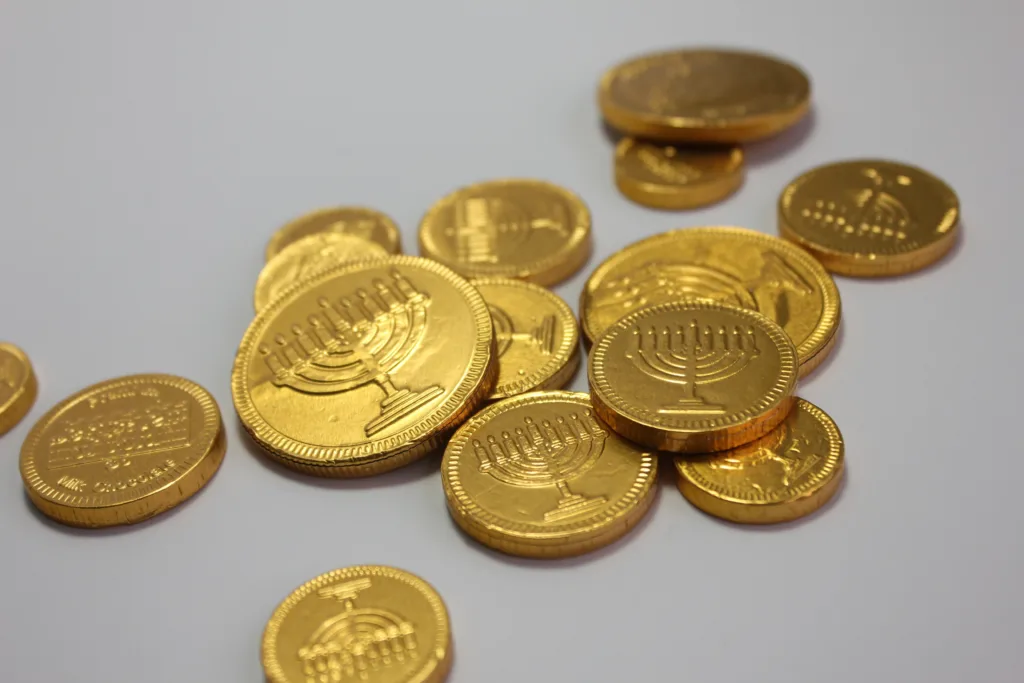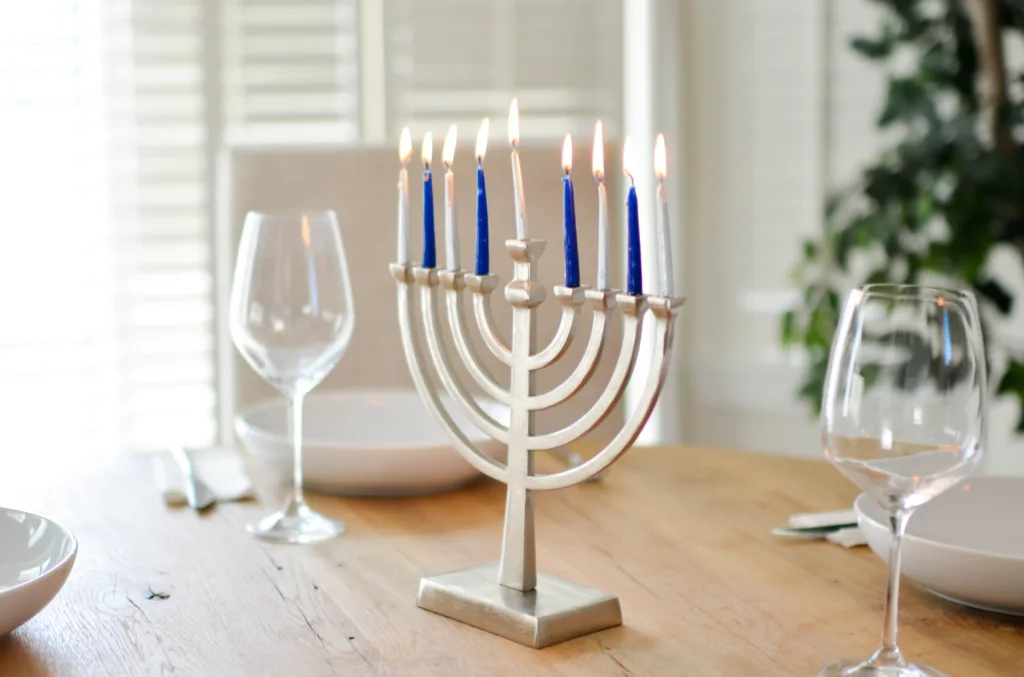Gelt, those shiny chocolate coins that are often associated with Hanukkah, hold a deeper meaning beyond their delicious taste. These treats, wrapped in gold or silver foil, symbolize the importance of charity and giving in Jewish culture.
The tradition of giving gelt during Hanukkah dates back centuries and has its roots in a different form. Originally, gelt was not chocolate but actual money. The practice began as a way to thank laborers for their hard work during the holiday season. Jewish families would give money to their children’s teachers, as well as to those who provided services throughout the year, such as housekeepers and workers.
Over time, the tradition shifted from giving real money to the more common practice of giving chocolate coins. This change allowed parents to teach their children about the importance of charity and giving to others. By giving gelt to their children, parents encourage them to share with friends and to understand the value of helping those in need.
The symbolism of gelt extends beyond the act of giving. The gold and silver foil wrapping represents the value and worth of the act of charity. It serves as a reminder that acts of kindness and generosity hold a special significance and should be cherished. The act of giving gelt during Hanukkah also reinforces the idea of gratitude and appreciation for the blessings and abundance in our lives.
In addition to gelt, Hanukkah is celebrated with various customs and traditions. Families come together to light the menorah, a nine-branched candelabrum, symbolizing the miracle of the oil that lasted for eight days in the ancient Jewish temple. Each night of Hanukkah, an additional candle is lit, along with the shamash, the central candle used to light the others.
Traditional Hanukkah foods also play a significant role in the celebrations. Potato pancakes, known as latkes, are a staple during this holiday. These crispy treats, often served with applesauce or sour cream, symbolize the miracle of the oil. Another popular Hanukkah treat is the jam-filled donut, called sufganiyot, which represents the sweetness of the holiday.
A beloved Hanukkah game involves spinning dreidels, four-sided tops with Hebrew letters on each side. Players take turns spinning the dreidel and following the instructions based on the letter that lands facing up. This game is a reminder of the Jewish people’s perseverance and the miracles that occurred during the Hanukkah story.
Exchanging gifts is another common Hanukkah tradition. While not a central aspect of the holiday, giving and receiving gifts during this time is a way to show love and appreciation for one another.
Gelt, those chocolate coins covered in gold or silver foil, symbolize the importance of charity and giving in Jewish culture. They serve as a reminder to children and adults alike to share with others and to understand the value of helping those in need. The tradition of giving gelt during Hanukkah has evolved from actual money to chocolate coins, but the symbolism remains the same. As we enjoy the sweet taste of gelt during Hanukkah, let us remember the significance of charity and gratitude that it represents.
What Does Hanukkah Gelt Symbolize?
Hanukkah Gelt, typically in the form of chocolate coins, holds symbolic significance during the holiday of Hanukkah. The word “gelt” itself is Yiddish for “money.” While it cannot be used as real currency, gelt serves as a representation of wealth and prosperity. Here are some key symbolic meanings associated with Hanukkah Gelt:
1. Commemoration of the Miracle: Hanukkah celebrates the miracle that occurred in the Second Temple of Jerusalem, where a small quantity of oil lasted for eight days. This miracle is often associated with the preservation of Jewish faith and culture. Gelt, in this context, symbolizes the monetary rewards and blessings that can come from staying true to one’s beliefs.
2. Remembrance of the Maccabean Revolt: Hanukkah also commemorates the Maccabean revolt against the oppressive Seleucid Empire. During this revolt, the Jewish people fought for religious freedom and independence. Gelt can symbolize the rewards and spoils of victory, representing the triumph over adversity and the preservation of Jewish identity.
3. Lesson in Charity and Giving: Gelt is commonly given to children during Hanukkah as a way to teach them about the importance of charity and giving to others. Parents encourage their children to share their gelt with friends and family, promoting acts of kindness and generosity. It serves as a reminder that wealth should be used to benefit others and contribute to the community.
4. Joy and Celebration: Hanukkah is a festive holiday filled with joy and celebration. Gelt adds to the merriment by providing a tangible symbol of abundance and happiness. It is often used in traditional games like dreidel, where children can win and exchange gelt as part of the festivities.
Hanukkah Gelt symbolizes various aspects of the holiday, including the commemoration of the miracle, remembrance of the Maccabean revolt, lessons in charity and giving, and the overall joy and celebration associated with Hanukkah.

What Is The Significance Of Gold Coins For Hanukkah?
The significance of gold coins for Hanukkah, known as gelt, can be traced back to historical traditions and customs. Here are some key points explaining their significance:
1. Historical context: Hanukkah commemorates the rededication of the Second Temple in Jerusalem and the miracle of the oil. According to the story, after the Maccabees defeated the Seleucid Empire, they found only enough pure oil to light the menorah for one day. Miraculously, the oil lasted for eight days until more could be obtained. This miracle is central to the Hanukkah celebration.
2. Symbolism of gold: Gold has long been associated with wealth, prosperity, and value in many cultures. In the context of Hanukkah, gold coins represent material abundance and the blessings of prosperity. They symbolize the hope for a bright future and the joyous celebration of the holiday.
3. Historical significance: The tradition of giving gelt during Hanukkah dates back to the Middle Ages. It originated as a way to thank laborers and teachers for their services and to encourage them to continue their work. Jewish families would give small amounts of money (real coins) to workers as a token of appreciation.
4. Evolution into chocolate coins: Over time, the practice of giving real money evolved into giving chocolate coins covered in gold or silver foil. This shift occurred as a way to make the tradition more child-friendly and enjoyable. Chocolate gelt became a popular treat for children during Hanukkah, and the practice continues today.
5. Teaching values: The tradition of giving gelt to children also serves as an opportunity to teach them about generosity, charity, and the importance of sharing. Parents often use gelt as a tool to teach children about the value of money and the act of giving during the holiday season.
Gold coins or gelt hold significance in Hanukkah as a symbol of prosperity and abundance. The tradition of giving gelt originated as a gesture of appreciation to laborers and teachers, and it has evolved into a beloved custom of giving chocolate coins to children during the holiday.
What Is Gelt Made From?
Gelt is made from chocolate, specifically milk chocolate. The chocolate used to make gelt is typically a blend of cocoa solids, cocoa butter, sugar, and milk powder. The exact recipe may vary slightly depending on the brand or manufacturer producing the gelt.
Here is a breakdown of the main ingredients in gelt:
1. Cocoa Solids: These are derived from cocoa beans and provide the rich chocolate flavor. Cocoa solids contain cocoa powder, which gives the chocolate its distinct taste.
2. Cocoa Butter: This is the fat naturally found in cocoa beans. It gives the chocolate its smooth and creamy texture. Cocoa butter also helps in melting the chocolate evenly and gives it a glossy appearance.
3. Sugar: Sugar is added to sweeten the chocolate and balance the bitterness of cocoa. It adds sweetness and enhances the overall flavor.
4. Milk Powder: Most gelt is made from milk chocolate, which means it contains milk powder. The milk powder adds a creamy and milky taste to the chocolate.
5. Additional Ingredients: Some variations of gelt may include additional ingredients such as vanilla extract, emulsifiers (e.g., soy lecithin), and flavorings to enhance the taste and texture.
Once the ingredients are blended together, the chocolate mixture is typically tempered to ensure proper crystallization and a shiny finish. It is then molded into coin-shaped pieces and wrapped in gold or silver foil to resemble traditional currency.
It’s important to note that gelt can come in various flavors and variations, including dark chocolate, white chocolate, and even flavored fillings. However, the traditional gelt is typically made from milk chocolate.
What Are 3 Traditions Of Hanukkah?
Hanukkah, also known as the Festival of Lights, is a Jewish holiday that is celebrated for eight days and nights. It commemorates the miracle of a small amount of oil that lasted for eight days in the ancient Temple in Jerusalem. Here are three traditions associated with Hanukkah:
1. Lighting the Menorah: One of the most well-known traditions of Hanukkah is the lighting of the menorah. A menorah is a special candelabra with nine branches. Each night during Hanukkah, a candle is lit, starting with one on the first night and adding an additional one each night until all eight candles are lit. The ninth branch of the menorah is called the shamash, which is used to light the other candles. The menorah is usually placed in a prominent location, such as a windowsill, to publicize the miracle of Hanukkah.
2. Playing with Dreidels: Another popular tradition during Hanukkah is playing with dreidels. A dreidel is a four-sided spinning top with Hebrew letters on each side. The letters stand for the phrase “Nes Gadol Haya Sham,” which means “a great miracle happened there.” Each player starts with an equal number of game pieces, such as coins or chocolate gelt, and takes turns spinning the dreidel. Depending on which letter the dreidel lands on, players either win or lose game pieces. This game is often played with family and friends as a way to celebrate the holiday.
3. Eating Traditional Foods: Food plays an important role in Hanukkah celebrations, with particular dishes being enjoyed during this festive time. Potato pancakes, known as latkes, are a staple of Hanukkah meals. They are made by shredding potatoes and mixing them with onions, eggs, and flour, then frying them until crispy. Latkes are typically served with applesauce or sour cream. Another popular Hanukkah treat is jam-filled donuts, called sufganiyot. These deep-fried donuts are usually filled with jelly or custard and topped with powdered sugar. The indulgence in these fried foods symbolizes the miracle of the oil that lasted for eight days.
Three traditions of Hanukkah include lighting the menorah, playing with dreidels, and enjoying traditional foods such as latkes and sufganiyot. These customs help to create a sense of joy and celebration during this eight-day holiday.

Conclusion
Gelt symbolizes more than just a sweet treat during Hanukkah. It carries a rich history and serves as a reminder of the importance of charity and giving to others. Originally used as real tips for labor, gelt has evolved into a symbol of gratitude and appreciation. Today, parents use it as a tool to teach their children about sharing and helping others. The gold and silver foil wrapping adds to the allure of the chocolate coins, making them a cherished tradition during the holiday. By exchanging gelt with friends and family, individuals are reminded of the value of generosity and the joy that comes from giving. So, next time you indulge in a piece of gelt, remember the deeper meaning behind this delicious treat and the lessons it represents.
